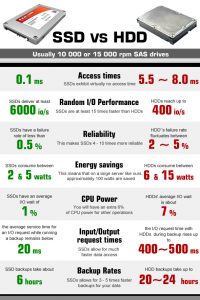OneDrive Files On Demand - Perfect For BYOD
Over the last couple of years it has been evident that increasing numbers of BYOD laptops have transitioned to Solid State Disks (SSD) which is terrific since they are significantly faster than traditional Hard Disk Drives (HDD), have lower failure rates and also improve battery life.
[caption id="attachment_8035" align="alignright" width="200"] Credit: TechnoFAQ[/caption]
Credit: TechnoFAQ[/caption]
However, due to their higher price point, the actual available storage volume of SSD is often markedly lower than equivalently priced HDD. This means students are faced with the difficult decision around what content do they store locally on the their device versus using selective sync in the OneDrive cloud and/or storing on an external USB drive.
Selective Sync effectively allows you to upload content into OneDrive that you don’t access frequently, and then download it when you do need it. Critically, however, this content will not appear in your local File Explorer browser so you can’t “see” it unless you log into OneDrive via a web browser and choose to sync it locally to your device.
OneDrive Files On Demand Coming In Windows 10 Fall Creators Update
This is why the announcement last Friday at the Build 2017 conference was so exciting. A new feature will allow you to see all of your content in OneDrive in your File Explorer, irrespective of whether it is stored locally on your device, or only in OneDrive in the Microsoft Cloud. Then, if you want to access any content that is only in OneDrive it will automatically be downloaded “on demand” when you click to open the file/folder.
You can optionally choose to then “always keep on this device” if you are going to be requiring regular or off-line access to this file.
Read the full blog post about this here.
Here are some images from the original blog post to show you how this works:
[caption id="attachment_1802" align="alignnone" width="584"] Note that the selected folder takes up 1.37TB of storage in the OneDrive cloud, but that locally in File Explorer it shows 0 bytes on the local device.[/caption]
[caption id="attachment_1803" align="alignnone" width="900"] The various status of each file and folder is shown in the “Status” column, indicating whether it is in the OneDrive Cloud only or stored locally on the device. Right mouse clicking allows you to choose to “Always keep on this device”[/caption]
[caption id="attachment_1804" align="alignnone" width="900"] If a file is not stored locally, simply double clicking on it as you normally would to open a file will immediately trigger a download to open the requested file.[/caption]
My Point of View:
I see this as being a massive aid for schools, helping both teachers and students maximize the performance of their devices. Getting more SSD into teacher and student devices will drive longer battery life, lower failure rates and faster accessing of content. However, by being able to seamlessly see what is in the Cloud and what is stored locally removes any barrier or confusion around the location of content for end users.
With many BYOD devices starting with 64GB of storage, this opens up the vast OneDrive storage capacity to students and teachers in an easier, more seamless way, meaning there is even less reason to use USB hard drives for storing content.
This feature will be available in the Windows 10 Fall Creators Update as well as new OneDrive features for iOS/Android devices.